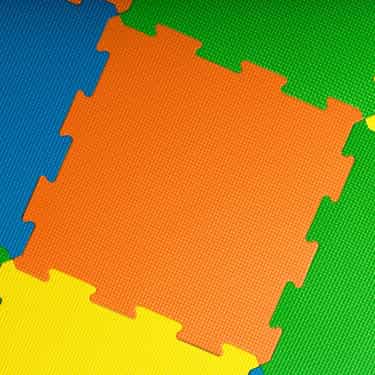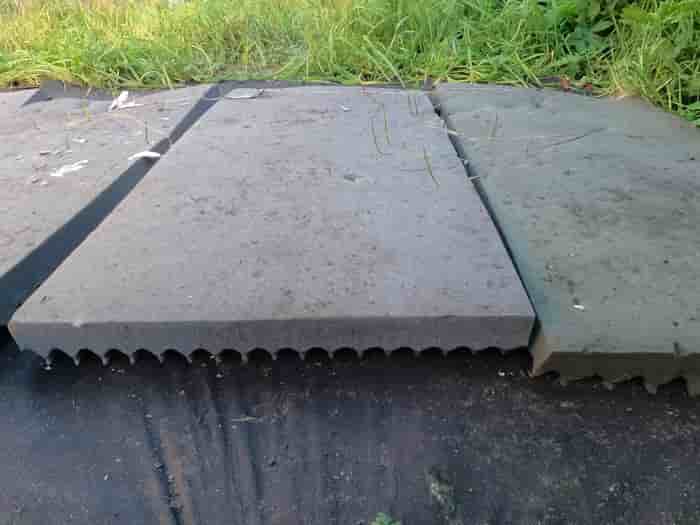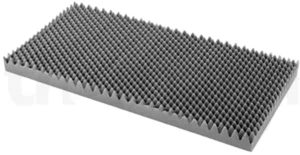When I first built my Intex frame pool, I followed the manual, but within a week I had to take my pool down again as what I had put under the pool was not good enough.
As a general rule, Intex recommends a ground cloth or tarp to be placed underneath the pool to protect the pool liner. In addition, I have found that adding a foam layer can further protect the pool from sharp objects such as stones, plus it will make the bottom of the pool feel soft underfoot.
What you put underneath your pool is really important to prevent leaks, damage and to maintain the manufacturer’s warranty.
I learnt the hard way and did not put sufficient protection underneath my pool when I first built it, which resulted in having to dismantle and refill my pool in the first week.
To really understand this problem, I tested different materials underneath my pool and spoke directly to Intex to get their advice.
In this article, I want to share
- What do Intex recommend putting under your pool?
- Why the basic Intex recommendations might not be enough
- My DIY solution and how it worked.
- What is the best material to put under an Intex pool?

What Do Intex Recommend To Put Under Your Pool?
The Intex customer service is excellent, so I asked Intex this question directly and here is what they said:
“A ground cloth or tarp should be placed under the pool before setting it up”
Intex Customer Service
Intex Customer Service further explained that the following points should be met:
- Ground surface should be hard, flat and 100% levelled.
- No sand under the pool.
- No loose soil under the pool.
- No sharp objects under the pool.
- No hardy or aggressive grass under the pool.
- Certain types of grass, such as St. Augustine and Bermuda, may grow through the liner. Intex will not replace the liner if grass grows through it.
The above points, 1-6, are also included in the manual.
In a nutshell, Intex recommends placing a ground cloth or tarp underneath your pool before setting it up. I have checked and rechecked the manual and this piece of information was not in there.
I love Intex. Their products and customer service are great and I am not complaining about them. But if you are wondering about what to put underneath your Intex pool, you might spend hours preparing the ground and still not get it right.
Despite a perfect ground, a tarp or strong material is still needed to prevent grass and weeds from piercing the pool. (For example, here is a link to a strong and heavy-duty tarp that I found on Amazon)
Despite following the manual exactly, you might run into further problems that you will not foresee until you actually build your pool, like I did.
Hopefully, the following will help you prepare and prevent unforeseen problems.
Why The Basic Intex Recommendations Might Not Be Enough
From my experience, I found that a ground cloth and tarp alone was not good enough to protect my pool.
Here is my experience and why my first attempt at building my Intex pool failed due to not placing the right material underneath it.
My Intex Pool Setup
Water is really heavy. When you fill a pool, even a small pool, it will press down hard onto the ground due to the weight of water.
I built my pool in my garden, on top of grass.
Following the instructions, I ensured the ground was absolutely flat, level, compacted, and firm.
In addition, I searched for stones, carefully checking the ground under the pool to ensure any small stones or objects were removed.
The grass itself is not an aggressive type, so I was not concerned about the grass growing through the liner, but I still used a tarp. (Here is a link to a heavy-duty tarp on Amazon)
Note: If you are placing your pool on or near an aggressive grass such as St. Augstine or Bermuda grass, you need to ensure you protect your pool as this grass can grow through the pool liner. If this happens, your warranty will be void and Intex will not cover repair.
Why I Still Had Problems With My Pool Setup
At first, the pool felt great, and I was confident I had done a good job.
I had followed the manual carefully, and everything looked good.
However, after about a week, I noticed I could feel small stones underneath my pool when walking in it barefoot.
This confused me, as I had removed all stones from beneath the pool. Then I realised that because pool water is so heavy, it compacted the soil so much the stones beneath the soil, which I could not see, surfaced.
I was concerned, as I could feel the pressure the pool liner was under as it was being pressed against these tiny stones.
With that much force, a tiny stone’s edge could pierce the pool liner.
I had to empty and take down my pool, as I was worried the liner would be damaged.
What I Learned About My Pool Setup
When I emptied my pool to investigate, I could not believe that it was just very tiny stones causing problems.
Although I had removed every stone I could find when building the pool, as the weight of the pool pressed down on the soil, it revealed a whole new layer of stones that was not in the original topsoil.
I was faced with two options:
- Remove this new layer of stones and fill my pool again.
- Find a permanent solution to fully protect the bottom of my pool.
I figured that removing the new layer of stones was not a good option as there was nothing stopping the pool from compacting the soil further and revealing a whole new layer of stones.
I did some research and managed to find a permanent solution that worked for me.
My DIY Solution & How It Worked
The following solution is something I did to reduce cost and get a suitable surface underneath my pool.
I am sharing it here as it will give you some idea of what to put underneath your pool. I have not seen this solution anywhere else, but it might help you understand what works underneath an Intex pool and help you find some of your own creative DIY methods to save money.
This DIY solution has been in operation for over a year now and works really well for me.
What I Placed Underneath My Intex Pool
When I first started researching what to put underneath my Intex pool, rigid foam gym tiles kept coming up as an option. These were and still are expensive.
In recent years, Intex have developed their own foam tiles, the Intex 29081 Pool Ground Protector Tiles. (Here is a link to them on Amazon). These are much cheaper and are a great option today, but unfortunately, these were not available to me when I was first building my pool.
If you can afford them, these are a great option, but if not; read on.

As mentioned, before Intex developed their own tiles, the regular gym foam tiles on the market were just too expensive for me.
I had just spent over £300 on an Intex pool and I was not prepared to spend nearly half that price again on rigid gym foam tiles.
For my pool, I placed tarp and 40mm thick acoustic foam panels underneath my pool. Unlike foam gym tiles, acoustic foam is much cheaper per square metre, which meant I could place foam underneath my pool that was more than half the price.

I had major concerns about doing this, and this was a real test. Being a fraction of the cost, however, I felt it was worth the gamble.
My biggest concerns were:
- The soft acoustic foam would be squashed to nothing under the weight of the pool, becoming useless.
- The soft acoustic foam would encourage vermin to move in.
Neither of these things happened.
Because of the large surface area of the pool, the foam remained plump underneath the pool, creating a lovely and soft surface underfoot.
If the stones pressed through the tarp layer underneath the pool, it would then be faced with the 40mm foam layer to push through. As a result, not one stone could be felt underfoot.
What I Learned Form This DIY Solution
Today, I would recommend using the purpose designed Intex 29081 Pool Ground Protector Tiles (Amazon Link). However, I did learn that you can use a simple DIY solution underneath your pool if you want a cheaper option.
Strong and soft material is what you need underneath your Intex pool, therefore anything that is strong enough to prevent grass growing through and soft enough to absorb any sharp object edges such as stones, will make a good solution.
A common DIY material used by many is carpet, as this is both strong and soft.
For me, my acoustic foam with tarp was both strong and soft. I had lots of acoustic foam in the house as I am a recording musician, so this was the material I had to hand that just worked. Plus, it is usually very cheap per square meter.
What Is The Best Material To Put Underneath An Intex Pool?
The best material to put underneath an Intex pool is tarp, plus a layer of Intex specially designed protector tiles.
Here is a link to heavy-duty tarp on Amazon, and here is a link to the Intex protector tiles.

These tiles interlock, so you can build up the necessary surface area for your specific pool.
In addition to the tiles, I recommend you still use a tarp underneath these tiles. Grass tends to grow in the slightest gap and it is possible for grass to grow up and through the gaps where the tiles join.
The great thing about this purchased option over DIY options is that these protector tiles can be cleaned and stored away until next season.
If you use a DIY option such as foam or carpet, it is much harder to clean and store this material over the winter if you decide to take your pool down.
From a cost point of view, they are not too expensive and are certainly cheaper than most of the other gym foam tiles recommended on the market.
In addition, as they are supplied by Intex, you can be confident you are picking the right solution for underneath your pool.
Before your go, did you know that you can properly swim and train in a simple above-ground Intex pool using a swimming harness? (A device like this on Amazon)
Here is a link to my story on how I started swimming laps in my small garden pool, “Can You Train In Above Ground Backyard Pool?“
Happy swimming!


